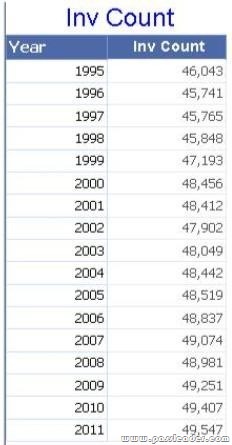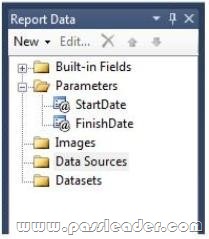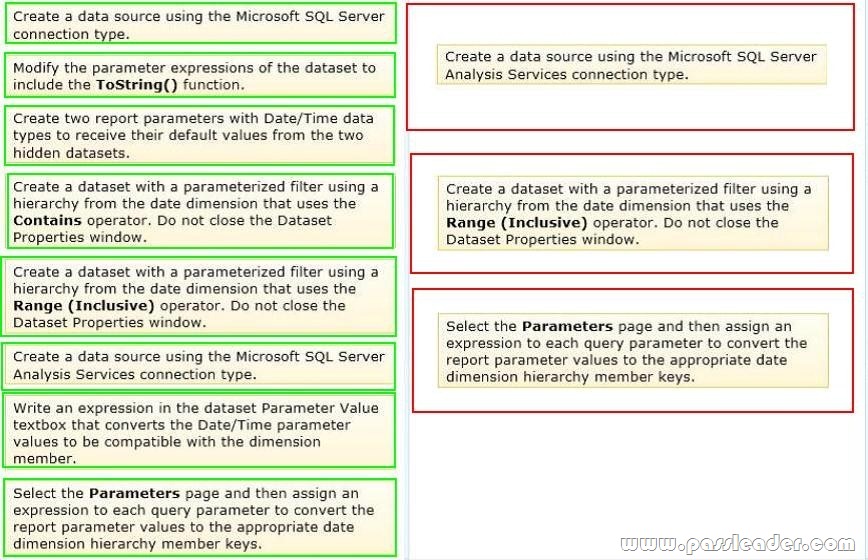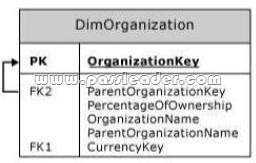Valid 70-466 Dumps shared by PassLeader for Helping Passing 70-466 Exam! PassLeader now offer the newest 70-466 VCE dumps and 70-466 PDF dumps, the PassLeader 70-466 exam questions have been updated and ANSWERS have been corrected, get the newest PassLeader 70-466 dumps with VCE and PDF here: http://www.passleader.com/70-466.html (186 Q&As Dumps)
BTW, DOWNLOAD part of PassLeader 70-466 dumps from Cloud Storage: https://drive.google.com/open?id=0B-ob6L_QjGLpfkVjSC1jeXI2a3Z0eHFmQmlwMTUzUzZLQkhoenVVcGZWZTVZanRYdHhwelU
QUESTION 46
You are developing a SQL Server Analysis Services (SSAS) tabular project that will be used by the finance, sales, and marketing teams. The sales team reports that the model is too complex and difficult to use. The sales team does not need any information other than sales related resources in the tabular model. The finance and marketing teams need to see all the resources in the tabular model. You need to implement a solution that meets the needs of the sales team while minimizing development and administrative effort. What should you do?
A. Create a separate tabular model for each team.
B. Hide the non-sales columns from the client tools.
C. Create a security role for the sales team.
D. Create a perspective for the sales team.
Answer: D
QUESTION 47
You are developing a SQL Server PowerPivot workbook that sources data from a SQL Azure database. The PowerPivot model includes a single table named FactSales that consists of four columns named Year, Country, Product, and Revenue. The model includes the following two measures.
– Sales:=SUM(FactSales[Revenue;)
– Sales %:=;Sales] / CALCULATE([Sales], ALL(FactSales))
In Microsoft Excel 2010 you create the following PivotTable report. Users report that the Sales % measure computes an incorrect ratio. The measure should meet a requirement to compute a ratio over all visible sales values defined by the query filters. The Grand Total value for the Sales % measure should equal 100%. You need to fix the Sales % measure to meet the requirement. Which Data Analysis Expressions (DAX) expression should you use?

A. =[Sales] / CALCULATE([Sales])
B. =[sales] / [Sales](ALLSELECTED(FactSales))
C. =[sales] / CALCULATE([Sales], VALUES(FactSales[Year]), VALUES(FactSales[Country]))
D. =[sales] / [Sales](ALLEXCEPT(FactSales, FactSales[Year]))
Answer: B
QUESTION 48
You are developing a SQL Server Analysis Services (SSAS) tabular project. You need to grant the minimum permissions necessary to enable users to query data in a data model. Which role permission should you use?
A. Explorer
B. Process
C. Administrator
D. select
E. Browser
F. Read
Answer: F
QUESTION 49
You are developing a SQL Server Analysis Services (SSAS) tabular project. The model includes a table named DimEmployee. The table contains employee details, including the sales territory for each employee. The table also defines a column named EmployeeAlias which contains the Active Directory Domain Services (AD DS) domain and logon name for each employee. You create a role named Employees. You need to configure the Employees roles so that users can query only sales orders for their respective sales territory. What should you do?
A. Add a row filter that implements only the USERNAME function.
B. Add a row filter that implements the LOOKUPVALUE and USERNAME functions.
C. Add a row filter that implements only the CUSTOMDATA function.
D. Add a row filter that implements the LOOKUPVALUE and CUSTOMDATA functions.
Answer: B
QUESTION 50
You are developing a Microsoft SQL Analysis Services (SSAS) multidimensional project. A fact table named FactHouseSales has a measure column named Area. All values in the column are stored in square feet. Users must be able to analyze the area in different units. You create a table named AreaUnit. Each row in the table consists of the unit name and a square feet conversion factor value. You need to implement the area conversion in the project. What should you do?
A. Use role playing dimensions.
B. Use the Business Intelligence Wizard to define dimension intelligence.
C. Add a measure that uses the Count aggregate function to an existing measure group.
D. Add a measure that uses the DistinctCount aggregate function to an existing measure group.
E. Add a measure that uses the LastNonEmpty aggregate function.
Use a regular relationship between the time dimension and the measure group.
F. Add a measure group that has one measure that uses the DistinctCount aggregate function.
G. Add a calculated measure based on an expression that counts members filtered by the Exists and NonEmpty functions.
H. Add a hidden measure that uses the Sum aggregate function.
Add a calculated measure aggregating the measure along the time dimension.
I. Create several dimensions.
Add each dimension to the cube.
J. Create a dimension.
Then add a cube dimension and link it several times to the measure group.
K. Create a dimension.
Create regular relationships between the cube dimension and the measure group.
Configure the relationships to use different dimension attributes.
L. Create a dimension with one attribute hierarchy.
Set the XsAggregatable property to False and then set the DefaultMember property.
Use a regular relationship between the dimension and measure group.
M. Create a dimension with one attribute hierarchy.
Set the IsAggregatable property to False and then set the DefaultMember property.
Use a many-to-many relationship to link the dimension to the measure group.
N. Create a dimension with one attribute hierarchy.
Set the ValueColumn property, set the IsAggregatable property to False, and then set the DefaultMember property.
Configure the cube dimension so that it does not have a relationship with the measure group.
Add a calculated measure that uses the MemberValue attribute property.
O. Create a new named calculation in the data source view to calculate a rolling sum.
Add a measure that uses the Max aggregate function based on the named calculation.
Answer: N
QUESTION 51
You are creating a SQL Server Analysis Services (SSAS) multidimensional database. Users need a time dimension for:
– Dates
– Delivery dates
– Ship dates
You need to implement the minimum number of required SSAS objects. What should you do?
A. Use role playing dimensions.
B. Use the Business Intelligence Wizard to define dimension intelligence.
C. Add a measure that uses the Count aggregate function to an existing measure group.
D. Add a measure that uses the DistinctCount aggregate function to an existing measure group.
E. Add a measure that uses the LastNonEmpty aggregate function.
Use a regular relationship between the time dimension and the measure group.
F. Add a measure group that has one measure that uses the DistinctCount aggregate function.
G. Add a calculated measure based on an expression that counts members filtered by the Exists and NonEmpty functions.
H. Add a hidden measure that uses the Sum aggregate function.
Add a calculated measure aggregating the measure along the time dimension.
I. Create several dimensions.
Add each dimension to the cube.
J. Create a dimension.
Then add a cube dimension and link it several times to the measure group.
K. Create a dimension.
Create regular relationships between the cube dimension and the measure group.
Configure the relationships to use different dimension attributes.
L. Create a dimension with one attribute hierarchy.
Set the XsAggregatable property to False and then set the DefaultMember property.
Use a regular relationship between the dimension and measure group.
M. Create a dimension with one attribute hierarchy.
Set the IsAggregatable property to False and then set the DefaultMember property.
Use a many-to-many relationship to link the dimension to the measure group.
N. Create a dimension with one attribute hierarchy.
Set the ValueColumn property, set the IsAggregatable property to False, and then set the DefaultMember property.
Configure the cube dimension so that it does not have a relationship with the measure group.
Add a calculated measure that uses the MemberValue attribute property.
O. Create a new named calculation in the data source view to calculate a rolling sum.
Add a measure that uses the Max aggregate function based on the named calculation.
Answer: A
QUESTION 52
You are designing a SQL Server Reporting Services (SSRS) report based on a SQL Server Analysis Services (SSAS) cube. The cube is used to measure sales growth by salesperson. The cube contains a Key Performance Indicator (KPI) to show if a salesperson’s sales are off target, slightly off target, or on target. You need to add a report item that visually displays the KPI status value as a red, yellow, or green flag. Which report item should you add?
A. a Sparkline
B. a Gauge that uses the Radial type
C. an Indicator
D. a Gauge that uses the Linear type
E. a Data Bar
Answer: C
QUESTION 53
You install SQL Server Reporting Services (SSRS). You need to back up a copy of the symmetric key. Which command should you run?
A. rskeymgmt-d
B. rskeymgmt-i
C. rskeymgmt-e-f %temp%\rs.key-p Password1
D. rskeymgmt-a-f %temp%\rs.key-p Password1
Answer: C
QUESTION 54
You are developing a SQL Server Reporting Services (SSRS) report. The report includes a dataset with fields named Year, MonthNumber, and InvCount. The report includes a table that displays the inventory count per year, as shown in the following diagram. You need to modify the table to include a graphical item displaying the inventory count trend to the right of the Inv Count column. What should you do?

A. Add an Indicator item to a new column on the right of the Inv Count column.
Select the Directional Indicator type and then select the MonthNumber field for Value.
B. Add a Sparkline item to a new column on the right of the Inv Count column.
Then select the InvCount field for Values and the MonthNumber field for Category Groups.
C. Add an Indicator item to a new column on the right of the Inv Count column.
Select the Directional Indicator type and then assign the MonthNumber field to the Start property.
D. Add a Sparkline item to a new column on the right of the Inv Count column.
Then select the InvCount field for Values and the MonthNumber field for Series Groups.
E. Add a text box to a new column on the right of the Inv Count column.
Then use a Go to report action to link to a separate report showing the monthly trend.
Answer: B
QUESTION 55
Drag and Drop Questions
You are developing a SQL Server Reporting Services (SSRS) report that sources data from a SQL Azure database and a SQL Server Analysis Services (SSAS) cube. The cube contains a date dimension and other dimensions. The report design includes two report parameters named StartDate and FinishDate as shown in the following diagram:

The Data Type property of the parameters is set to Date/Time. The Data Type property of the parameters is set to Date/Time. You need to create the dataset based on the SSAS cube. You also need to ensure that the dataset is filtered by the existing report parameters. Which three actions should you perform in sequence? (To answer, move the appropriate actions from the list of actions to the answer area and arrange them in the correct order.)

Answer:

Explanation:
– In Reporting Services, a dataset is based on an existing a data source. A dataset specifies a query, query parameters, filters, and a field collection. You can also specify data options, such asd case, collation, kanatype, width, and accent, for the data retrieved from the data source. For more information, see Understanding Report Datasets. To create a dataset, you must have defined an embedded or shared data source.
– When you deploy Reporting Services, a set of data processing extensions are automatically installed and registered on both the report authoring client and on the report server to provide access to a variety of data source types . SQL Server 2008 Reporting Services (SSRS) installs the following data source types: Microsoft SQL Server, Microsoft SQL Server Analysis Services, Oracle, SAP NetWeaver BI, Hyperion Essbase, Teradata, OLE DB, ODBC, and XML.
– To define a query parameter in MDX in Design modeAfter you run the query, click Design on the toolbar to toggle to Query mode to view the MDX query that was created. Do not change the query text in Query mode if you want to continue to use Design mode to develop the query. Click Design to toggle back to Design mode.
– To create a datasetIn a few cases, the field collection specified by the query can only be determined by running the query on the data source. For example, a stored procedure may return a variable set of fields in the result set. Click Refresh Fields to run the query on the data source and retrieve the field names that are needed to populate the dataset field collection in the Report Data pane. The field collection appears under the dataset node after you close the Dataset Properties dialog box. The dataset and its field collection appear in the Report Data pane under the data source node.
Reference: How to: Create a Dataset (Reporting Services)
Reference: How to: Define Parameters in the MDX Query Designer for Analysis Services (Report Builder 3.0 and SSRS)
QUESTION 56
Drag and Drop Questions
You are planning the installation of PowerPivot for SharePoint. You install SharePoint Server 2010 Enterprise Edition with Service Pack 1. You need to install the PowerPivot for SharePoint instance. Then you need to configure the Default Account username used to provision shared services in the SharePoint farm. Which three actions should you perform in sequence? (To answer, move the appropriate actions from the list of actions to the answer area and arrange them in the correct order.)

Answer:

Explanation:
Update an expired password for SQL Server Analysis Services (PowerPivot) instance.
Reference: Change Service Accounts and Passwords (PowerPivot for SharePoint)
QUESTION 57
You have a server that has SQL Server 2012 installed. You need to identify which parallel execution plans are running in serial. Which tool should you use?
A. Data Profile Viewer
B. Database Engine Tuning Advisor
C. Performance Monitor
D. Extended Events
Answer: D
QUESTION 58
You have a database named database1. Database developers report that there are many deadlocks. You need to implement a solution to monitor the deadlocks. The solution must meet the following requirements:
– Support real-time monitoring.
– Be enabled and disabled easily.
– Support querying of the monitored data.
What should you implement? More than one answer choice may achieve the goal. Select the BEST answer.
A. an Extended Events session
B. a SQL Server Profiler template
C. log errors by using trace flag 1204
D. log errors by using trace flag 1222
Answer: A
QUESTION 59
You are developing a multidimensional project that includes a dimension named Organization. The dimension is based on the DimOrganization table in the data warehouse. The following diagram illustrates the table design. The Organization dimension includes a parent-child hierarchy named Organizations. The dimension includes the following dimension attributes:
– Organization, which is a key attribute.
– Organizations, which defines the parent-child hierarchy.
– Currency Code, which is a regular attribute.
When users browse the dimension, three hierarchies are visible to them. You need to ensure that the Organization hierarchy is not visible to users. What should you do?

A. Set the AttributeHierarchyDisplayFolder property to Null for the Organization attribute.
B. Delete the Organization attribute.
C. Set the AttributeHierarchyEnabled property to False for the Organization attribute.
D. Set the AttributeHierarchyVisible property to False for the Organization attribute.
Answer: D
QUESTION 60
You are conducting a design review of a multidimensional project. In the geography dimension, all non-key attributes relate directly to the key attribute. The underlying data of the geography dimension supports relationships between attributes. You need to increase query and dimension processing performance. What should you do?
A. For the geography dimension, set the ProcessingMode property to LazyAggregations
B. For the dimension attributes of the geography dimension, define appropriate attribute relationships.
C. For the geography dimension, set the ProcessingPriority property to 1.
D. For the dimension attributes of the geography dimension, set the GroupingBehavior property to EncourageGrouping.
Answer: B
Get the newest PassLeader 70-466 VCE dumps here: http://www.passleader.com/70-466.html (186 Q&As Dumps)
And, DOWNLOAD the newest PassLeader 70-466 PDF dumps from Cloud Storage for free: https://drive.google.com/open?id=0B-ob6L_QjGLpfkVjSC1jeXI2a3Z0eHFmQmlwMTUzUzZLQkhoenVVcGZWZTVZanRYdHhwelU